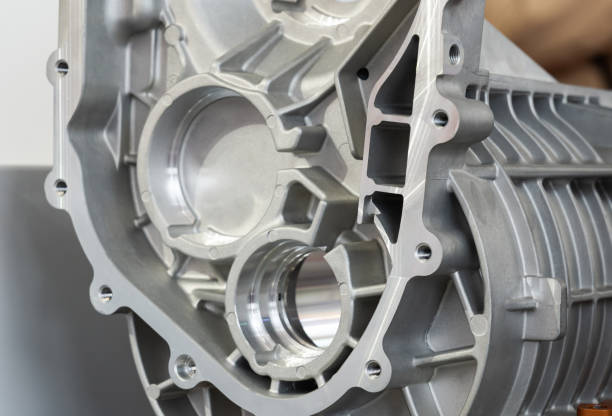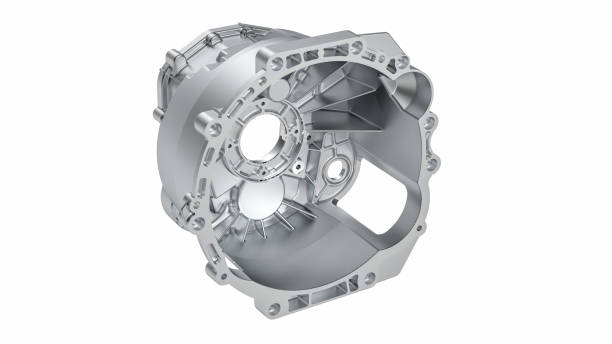Die casting is a way to make things that has been used in many businesses for a long time. It includes injecting molten metal under high pressure into a mold cavity, where it cools and hardens to make a solid metal part. Die casting is one of the most popular ways to make engine blocks, which are important parts in the automotive industry. In this lesson, we’ll look at the different parts of die casting for making engine blocks.
Materials used in engine block die casting

When die casting engine blocks, the choice of material is very important because it directly affects how well and how long the end product will last. Aluminum alloys, zinc alloys, magnesium alloys, and copper alloys are some of the materials that are most often used for this. Each material has its own special qualities that make it good for certain tasks.
Aluminum metals are the most popular choice for making engine blocks because they are strong for how light they are, resistant to corrosion and good at transferring heat. Because zinc metals have a low melting point and are easy to work with, they are often used for smaller engine blocks.
Because magnesium metals are light and have good damping, they are perfect for high-performance engines. Copper alloys aren’t used very often, but they are known for their good electrical qualities and high thermal conductivity.
How an engine block is made by die casting?
Die casting engine blocks includes several steps, such as making the mold, pouring molten metal into it, letting it cool and harden, and then pulling the casting out of the mold. The first step is to make a mold that fits what the engine block will look like and how big it will be.

Once the mold is ready, high pressure is used to force molten metal into the shape. After the metal cools and hardens, the casting is taken out of the mold.
The pros of engine block die casting
When it comes to making engine blocks, die casting has a number of benefits over other methods. The process makes it possible for the parts to have accurate sizes, smooth surfaces, high output rates, and different designs. With the help of sophisticated simulation software, producers can also improve the casting process and waste less material.
The process of making an engine block casting
There are many different ways to make engine blocks. Depending on the type of engine block needed, each method has its own pros and cons. Sand casting, fixed mold casting, die casting, and investment casting are the four main ways that engine blocks are made.
Sand casting is an old method that is still used a lot in the auto business. To make the engine block, sand is used to make a mold, which is then filled with liquid metal. Sand casting is a cheap way to make something, but it is not as accurate as other ways.
Permanent mold casting is a way to make an engine block with a model made of steel or cast iron that can be used more than once. After pouring the liquid metal into the mold, the block is left to cool and harden. This method is more accurate than sand casting and can make surfaces that are smoother.
Die casting is a fast method that makes engine blocks that are accurate and have a lot of parts. High pressure is used to force liquid metal into a mold. The process is faster and better than other ways to do things, but it also costs more.
Investment casting, which is also called “lost-wax casting,” is a method in which an engine block pattern is made out of wax and then covered with a ceramic shell. When the wax melts, it leaves a hole that is filled with liquid metal. This method makes engine blocks that are very detailed and accurate, but they also cost more than other ways.
Casting aluminum engine blocks is a complicated process that takes a lot of skill, precision, and attention to detail.
Here’s a step-by-step guide on how to make engine blocks out of aluminum:

1. Make the Form: First, a model for the engine block needs to be made. You can do this with a mold that is already made or by making your own. If you decide to make your own, you should make sure the mold is correct and exact. The mold needs to be made of steel or iron, which can handle high heat and pressure.
2. Get the aluminum ready: The next step is to get the aluminum ready so that it can be used to make the engine block. Aluminum metals are often used for engine blocks because they are strong and don’t weigh much. In a furnace heated to about 660 degrees Celsius, the metal needs to be melted down. This method is called “smelting.”
Pour the metal: After the metal has been melted, it is poured into the mold. Before pouring the aluminum, the mold needs to be heated to about 250 degrees Celsius so that it doesn’t cool too fast and cause flaws in the engine block.
4. Cool the engine block. After the metal has been poured into the mold, the engine block needs time to cool and harden. This usually takes a few hours, and it’s important to make sure the engine block cools down evenly and at a steady rate.
5. Take the engine block out of the mold. After the engine block has cooled and hardened, it is taken out of the mold. You can do this with a hydraulic press or some other special tool. The engine block will need to be cleaned and looked over for any flaws.
6. Machining: Machine work is the last step in making an aluminum engine block. To make and finish the engine block, specialized tools like a CNC machine are used. The process of grinding is important to make sure that the engine block is accurate and meets all of the requirements.
Conclusion
Casting aluminum engine blocks is a highly specialized process that takes a lot of equipment and knowledge. It’s not good for people who are just starting out or don’t have the right skills and experience. When working with molten metal, it is also important to take all safety measures, such as wearing protective clothing and tools.








